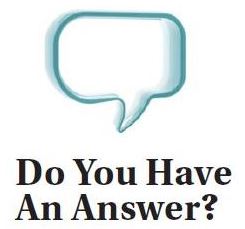Question: How Do You Handle Preoccupied Clients?

A DISTRIBUTOR ASKS: I feel like we can all agree that having a paper trail is beneficial in our business. However, I’ve noticed that some of my clients tend to skim over emails, overlook details and sometimes procrastinate on decisions that need to be made. Communication is also stymied when the business owner delegates an order to an employee without giving this person all the necessary information. Then the employee makes decisions that are later changed by the business owner, which further slows the process.
––––––––––––
I’ve spent a lot of time repeating what I need to these clients and scrambling to help them at the last minute because of their procrastination and lack of attention to details that were previously provided, both in verbal and written form. For example, I might say, “I need to know XXX before I can process your order, and I will need it by XXX to deliver it on your timeline.” Then I receive a reply that says, “Yes, please go ahead,” without answering any of my questions or providing the information I’ve requested.
Here are some things I’ve tried: listing items that need answers with bullet points; communicating processes, deadlines and needed information often and repeatedly during in-person conversations; and putting details of delivery dates, timelines and needed/missing information in writing on quotes. How do you handle this?
It can be tough to get people of all ages to answer multiple questions in an email. Sometimes starting with, “I have THREE questions,” and then numbering the questions will help. If they miss some answers, you can, perhaps, forward the reply back and highlight the missed questions, asking, “May I have these two answers please?” If that approach fails, you might find it better to use something like SurveyMonkey or some other form tool, which allows you to require an answer before they move onto the next question.
Jennifer Reissaus, MAS
Advertising Specialties Alliance/Kaeser & Blair
- Your order is on hold. I have found this subject line to be a good way to get people to pay attention to an email.
- Your action is required. This is another email subject line that helps get attention.
- Use headlines and bullet points. This makes it easier for people to scan emails for what you need.
- Shrink your browser. A colleague who works on complex branding projects told me they had the same problem you are describing. Now, when they write emails, they narrow their browser so it mimics the width of a phone screen. Try that and see how your message looks.
- Schedule a meeting. Scheduling regular, planned meetings in person or on the phone gives you a chance to find out what projects and dates are coming up so you can be proactive.
- Charge them more. Full-service clients should pay full-service rates.
- Sometimes say “no.” If you need to drop everything else you are doing for two hours to solve their problem, sometimes it’s ok to let them know there is a limit to how much you can do to make up for their mismanagement.
- Recognize the opportunity. Disorganized people really need our help. If you can solve some of their planning and execution problems, they can become very loyal clients. Getting them to commit to regularly scheduled planning meetings is key.
Jamie Bradley
President
Sophwell
Woburn, Massachusetts
There are two issues here: poor management, which you probably can’t solve, and the poor communication (thinking?) skills of the texting generation. I have one client who fits this same profile. It takes about 100 emails and several phone calls per order. One thing I’ve learned is to ask only one question at a time, i.e. Which pen do you like? What color pen do you want? What imprint do you want? What color imprint do you want? This takes forever, but only one question can be processed per communication. Bullet points don’t help. Colored text doesn’t help. Only one short, specific question per transaction, and this same question may be processed repeatedly. And then, late in the game, the boss might still make a different decision or decide he can’t afford the order. It’s so painful.
“When will you need this?” is something to ask at the outset. Then you can start setting deadlines for the customer and explain, in one statement, that the decisions need to be made and the order needs to be placed by XXX date. This may not change their behavior, but at least you’ve set a limit and can keep reminding them that they’re not going to have their order by XXX date. I call this “bowling in the dark.” I try to put as little energy into this as possible because I know at the outset that it’s going to be a dreadful process.
Jeryn Freeman
President
LogoPro, Inc.
Clemmons, North Carolina
I usually resend the same email with a new message, saying: PLEASE SEE BELOW…
I also found the clients answer more often if I put them in bullet points rather than putting my questions in the body of the email. For example:
- What is the quantity?
- Do you want to use your one-color or two-color logo?
- What date do you need these items?
Joe Jaggie
Owner
Jag Promotions
Ellisville, Missouri
I’m afraid that if you are going to be in this business, you will find this problem to be the nature of the beast. As frustrating as it is, you will always find yourself babysitting some people. And unless you do want to “fire” them, that’s how it will be. They expect you to make everything right and that is your job. The question is, how important is the client to you? Grin and bear it! You will be the hero in the end.
Tom Flynn
Co-owner
Flynnco Promotional Products, LLC
Gilbert, Arizona
When I feel like I’m spinning my wheels to get some basic questions answered for an order, I pick up the phone and actually call the customer. Not too many people do that anymore and it can get their attention. I try to follow up our phone conversation with an email summarizing the results of our discussion, so we’re all on the same page moving forward.
Karen Bradley
President
Marketing Enterprises of WNC
Weaverville, North Carolina
Yes, this is a growing issue for which I’ve taken a project management approach. In other words, we bill our clients for our time based on a 15-minute minimum for each client interaction. This fee is communicated to each prospect or client at our first meeting or project proposal. Thus, our clients are more mindful that as projects get delayed, their costs are increasing. Also, I often try to meet with clients face-to-face and present them with a meeting agenda beforehand.
Noel R. Choquette
President
ENOSIS Graphic Solutions
Worcester, Massachusetts
Asking one question at a time, while often time-consuming, can be a better option than asking the same two questions seven different times. Oddly enough, it may save time in the end. I’ve also found that utilizing email signatures has been a great time-saver for me. Even if it’s not an actual signature but a template, it’s been perfect for what I need. If you ask the same questions for each initial order request, just create a signature that says, “I need the following information in order to continue.” (List the questions in bullets). If they’ve already answered a question, just delete that one before you send the email.
Amber Jewell
Office Manager
Biggerfish Dallas, Texas
–––––––––––––––––––––––––––––––––––––––––––––––

A Distributor Asks: What are other distributors doing for self-promos and thank-you gifts? In past years, I’ve done umbrellas, tumblers, tech items, nice bags, clocks, etc. I’m looking for something different. About 30 percent of my clients have been with the company for more than eight years, so I need new ideas. I was thinking about a nice t-shirt because about 50 percent of my business is t-shirts and polos. Fresh ideas, please!
What’s Your Answer?
Email answers along with your name, title and company name by December 15 to Question@ppai.org for possible inclusion in an upcoming issue of PPB magazine.
–––––––––––––––––––––––––––––––––––––––––––––––
Danielle Renda is associate editor of PPB.

